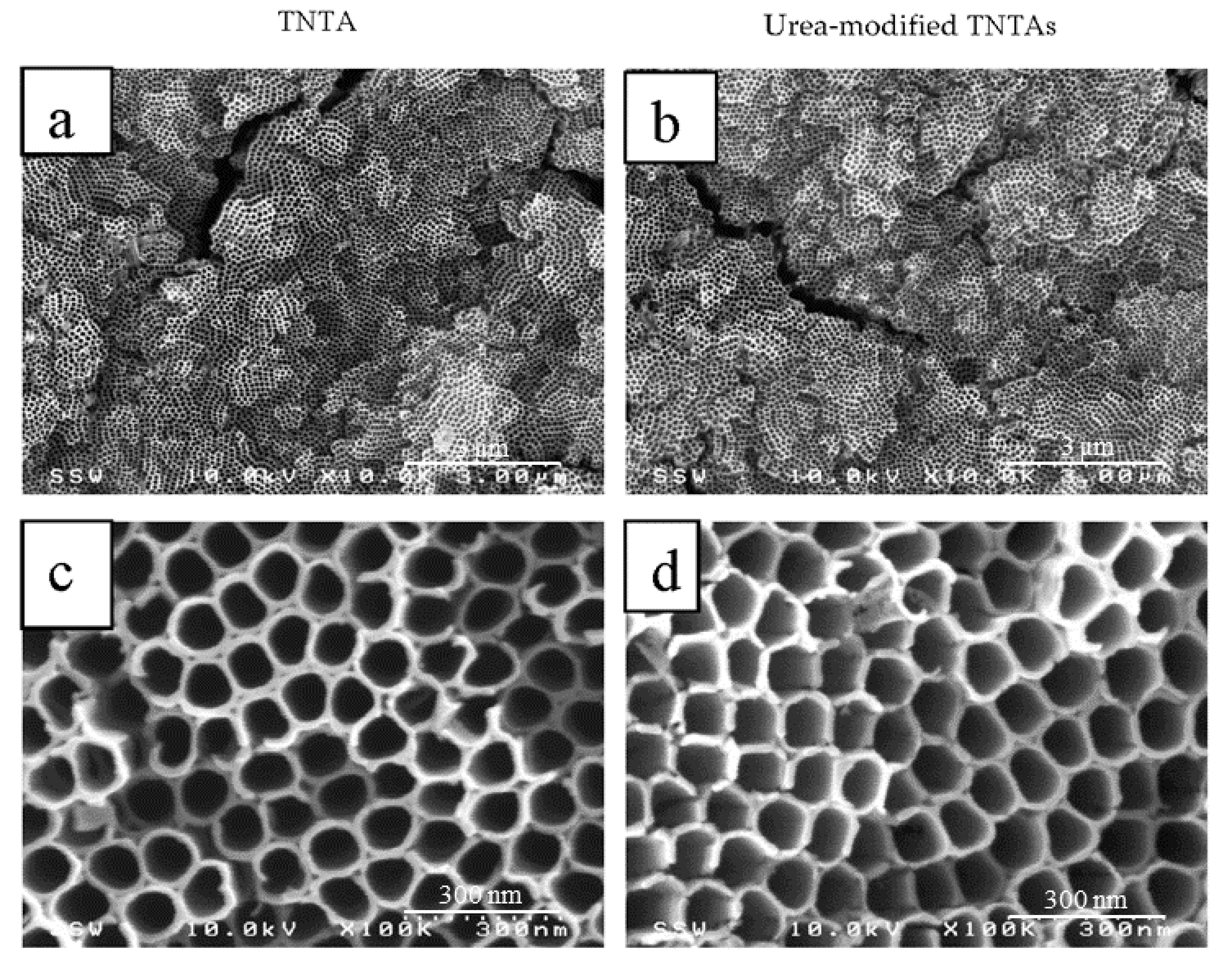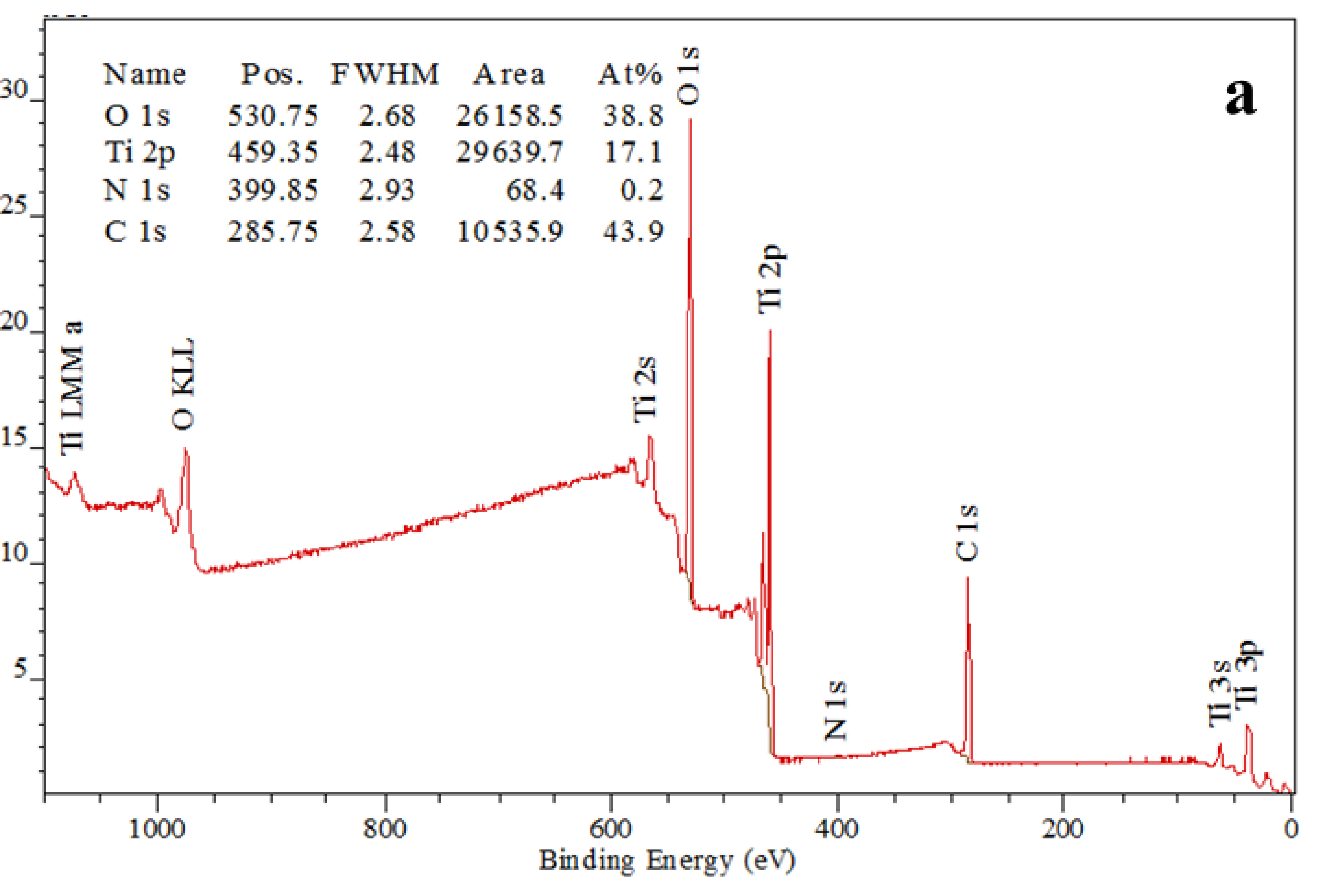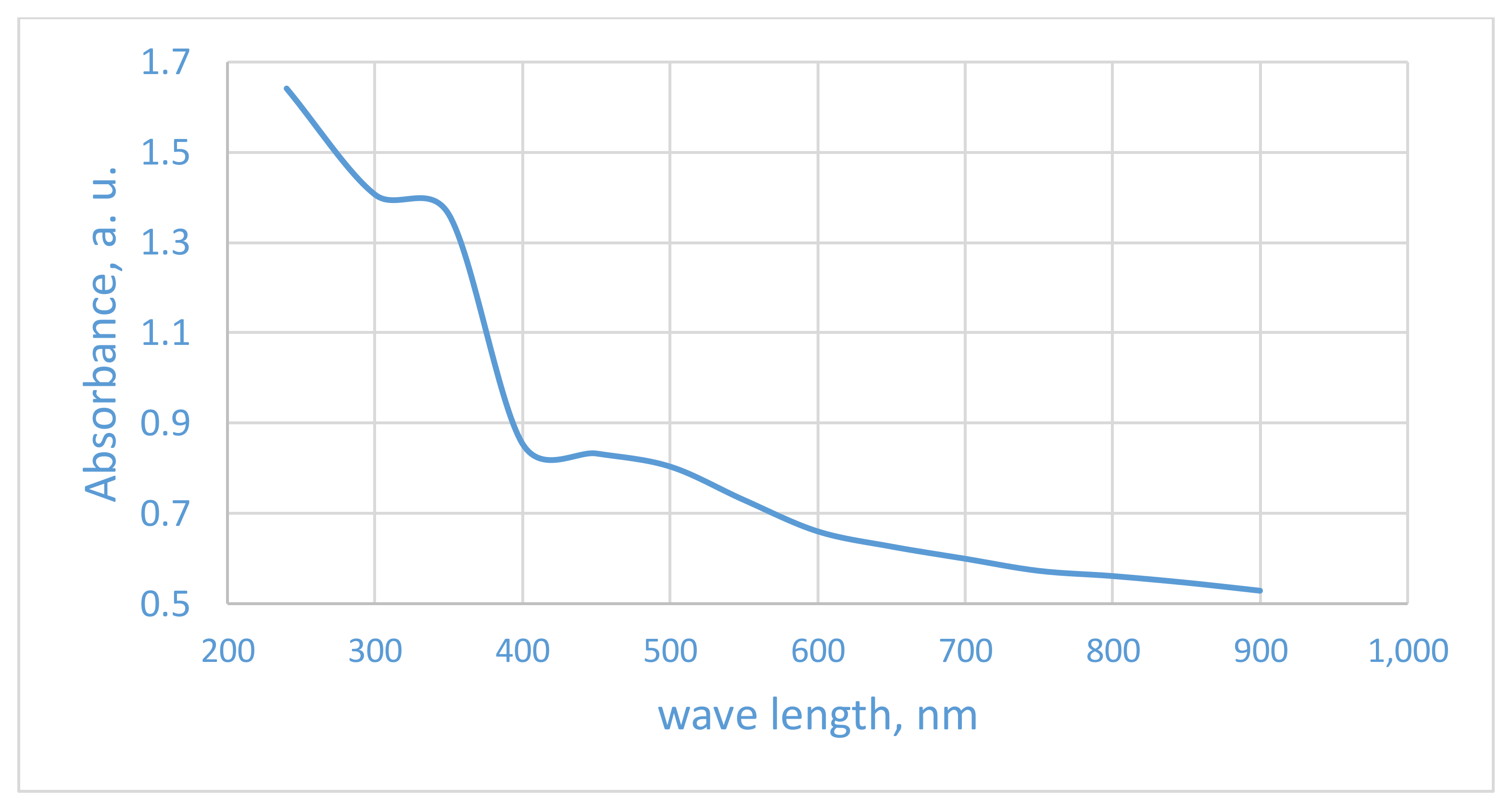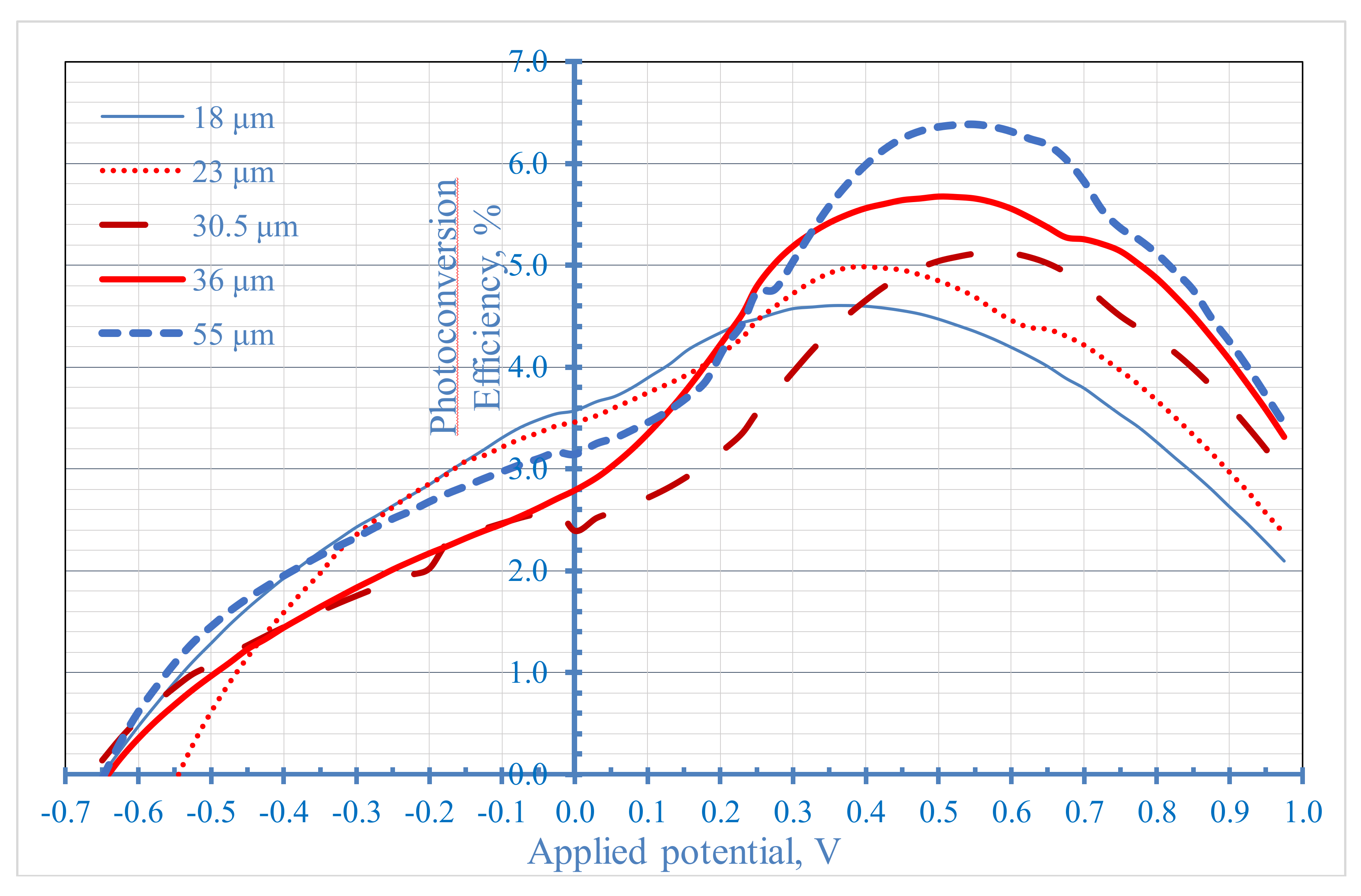N- and C-Modified TiO2 Nanotube Arrays: Enhanced Photoelectrochemical Properties and Effect of Nanotubes Length on Photoconversion Efficiency
Abstract
:1. Introduction
2. Experimental Setup and Methods
2.1. Preparation of Modified TiO2 Nanotube Arrays (TNTAs)
2.2. Characterization of Modified TNTAs
2.3. Photoelectrochemical Properties
3. Results and Discussion
3.1. FESEM and XRD Studies
3.2. EDX and XPS Results
3.3. Optical Properties
3.4. Photoelectrochemical Properties
4. Conclusions
Acknowledgments
Author Contributions
Conflicts of Interest
References
- Zwilling, V.; Darque-Ceretti, E.; Boutry-Forveille, A.; David, D.; Perrin, M.Y.; Aucouturier, M. Structure and physicochemistry of anodic oxide films on titanium and TA6V alloy. Surf. Interface Anal. 1999, 27, 629–637. [Google Scholar] [CrossRef]
- Lu, N.; Zhao, H.; Li, J.; Quan, X.; Chen, S. Characterization of boron-doped TiO2 nanotube arrays prepared by electrochemical method and its visible light activity. Sep. Purif. Technol. 2008, 62, 668–673. [Google Scholar] [CrossRef]
- Prakasam, H.E.; Shankar, K.; Paulose, M.; Varghese, O.K.; Grimes, C.A. A New Benchmark for TiO2 Nanotube Array Growth by Anodization. J. Phys. Chem. C 2007, 111, 7235–7241. [Google Scholar] [CrossRef]
- Ong, K.G.; Varghese, O.K.; Mor, G.K.; Grimes, C.A. Numerical simulation of light propagation through highly-ordered titania nanotube arrays: Dimension optimization for improved photoabsorption. J. Nanosci. Nanotechnol. 2005, 5, 1801–1808. [Google Scholar] [CrossRef]
- Ong, K.G.; Varghese, O.K.; Mor, G.K.; Shankar, K.; Grimes, C.A. Application of finite-difference time domain to dye-sensitized solar cells: The effect of nanotube-array negative electrode dimensions on light absorption. Sol. Energy Mater. Sol. Cells 2007, 91, 250–257. [Google Scholar] [CrossRef]
- Grimes, C.A.; Mor, G.K. Titania Nanotube Arrays: Synthesis, Properties, and Applications; Springer Science + Business Media, LLC: New York, NY, USA, 2009. [Google Scholar]
- Zhao, J.; Wang, X.; Chen, R.; Li, L. Fabrication of titanium oxide nanotube arrays by anodic oxidation. Solid State Commun. 2005, 134, 705–710. [Google Scholar] [CrossRef]
- Wang, H.; Yip, C.T.; Cheung, K.Y.; Djurisic, A.B.; Xie, M.H.; Leung, Y.H.; Chen, W.K. Titania-nanotube-array-based photovoltaic cells. Appl. Phys. Lett. 2006, 89, 023508. [Google Scholar] [CrossRef]
- Paulose, M.; Shankar, K.; Varghese, O.K.; Mor, G.K.; Grimes, C.A. Application of highly-ordered TiO2 nanotube-arrays in heterojunction dye-sensitized solar cells. J. Phys. D 2006, 39, 2498–2503. [Google Scholar] [CrossRef]
- Chen, P.; Brillet, J.; Bala, H.; Wang, P.; Zakeeruddin, S.M.; Gratzel, M. Solid-state dye-sensitized solar cells using TiO2 nanotube arrays on FTO glass. J. Mater. Chem. 2009, 19, 5325–5328. [Google Scholar] [CrossRef]
- Jennings, J.R.; Ghicov, A.; Peter, L.M.; Schmuki, P.; Walker, A.B. Dye-Sensitized Solar Cells Based on Oriented TiO2 Nanotube Arrays: Transport, Trapping, and Transfer of Electrons. J. Am. Chem. Soc. 2008, 130, 13364–13372. [Google Scholar] [CrossRef] [PubMed]
- Wen, X.; Tao, J.; Sun, Y.; Sun, Y.; Dai, N. TiO2 nanotube arrays for quantum dots sensitized solar cells. In International Symposium on Photoelectronic Detection and Imaging 2009, Laser Sensing and Imaging: 17–19 June 2009, Beijing, China; Proceedings of SPIE Series Volume 7382; International Society for Optics and Photonics (SPIE): Bellingham, WA, USA, 2009. [Google Scholar] [CrossRef]
- Yoriya, S.; Prakasam, H.E.; Varghese, O.K.; Shankar, K.; Paulose, M.; Mor, G.K.; Latempa, T.J.; Grimes, C.A. Initial Studies on the Hydrogen Gas Sensing Properties of Highly-Ordered High Aspect Ratio TiO2 Nanotube-Arrays 20 µm to 222 µm in Length. Sens. Lett. 2006, 4, 334–339. [Google Scholar] [CrossRef]
- Xiao, P.; Garcia, B.B.; Guo, Q.; Liu, D.; Cao, G. TiO2 nanotube arrays fabricated by anodization in different electrolytes for biosensing. Electrochem. Commun. 2007, 9, 2441–2447. [Google Scholar] [CrossRef]
- Fujishima, A.; Honda, K. Electrochemical photolysis of water at a semiconductor electrode. Nature 1972, 238, 37–38. [Google Scholar] [CrossRef] [PubMed]
- Paulose, M.; Mor, G.K.; Varghese, O.K.; Shankar, K.; Grimes, C.A. Visible light photoelectrochemical and water-photoelectrolysis properties of titania nanotube arrays. J. Photochem. Photobiol. A 2006, 178, 8–15. [Google Scholar] [CrossRef]
- Paulose, M.; Shankar, K.; Yoriya, S.; Prakasam, H.E.; Varghese, O.K.; Mor, G.K.; Latempa, T.A.; Fitzgerald, A.; Grimes, C.A. Anodic Growth of Highly Ordered TiO2 Nanotube Arrays to 134 μm in Length. J. Phys. Chem. B 2006, 110, 16179–16184. [Google Scholar] [CrossRef] [PubMed]
- Mohapatra, S.K.; Misra, M.; Mahajan, V.K.; Raja, K.S. Design of a Highly Efficient Photoelectrolytic Cell for Hydrogen Generation by Water Splitting: Application of TiO2−xCx Nanotubes as a Photoanode and Pt/TiO2 Nanotubes as a Cathode. J. Phys. Chem. C 2007, 111, 8677–8685. [Google Scholar] [CrossRef]
- Hu, X.; Zhang, T.; Jin, Z.; Zhang, J.; Xu, W.; Yan, J.; Zhang, J.; Zhang, L.; Wu, Y. Fabrication of carbon-modified TiO2 nanotube arrays and their photocatalytic activity. Mater. Lett. 2008, 62, 4579–4581. [Google Scholar] [CrossRef]
- Linsebigler, A.L.; Lu, G.; Yates, J.T., Jr. Photocatalysis on TiO2 surfaces: principles, mechanisms, and selected results. Chem. Rev. 1995, 95, 735. [Google Scholar] [CrossRef]
- Nakamura, R.; Ohashi, N.; Imanishi, A.; Osawa, T.; Matsumoto, Y.; Koinuma, H.; Nakato, Y. Crystal-Face Dependences of Surface Band Edges and Hole Reactivity, Revealed by Preparation of Essentially Atomically Smooth and Stable (110) and (100) n-TiO2 (Rutile) Surfaces. J. Phys. Chem. B 2005, 109, 1648–1651. [Google Scholar] [CrossRef] [PubMed]
- Neumann, B.; Bogdanoff, P.; Tributsch, H.; Sakthivel, S.; Kisch, H. Electrochemical mass spectroscopic and surface photovoltage studies of catalytic water photooxidation by undoped and carbon-doped titania. J. Phys. Chem. B 2005, 109, 16579–16586. [Google Scholar] [CrossRef] [PubMed]
- Zhao, Q.; Li, X.; Wang, N.; Hou, Y.; Quan, X.; Chen, G. Facile fabrication, characterization, and enhanced photoelectrocatalytic degradation performance of highly oriented TiO2 nanotube arrays. J. Nanopart. Res. 2009, 11, 2153–2162. [Google Scholar] [CrossRef]
- Tian, T.; Xiao, X.-F.; Liu, R.-F.; She, H.-D.; Hu, X.-F. Study on titania nanotube arrays prepared by titanium anodization in NH4F/H2SO4 solution. J. Mater. Sci. 2007, 42, 5539–5543. [Google Scholar] [CrossRef]
- Brunette, D.M.; Tengvall, P.; Textor, M.; Thomsen, P. Titanium in Medicine; Springer: Berlin, Germany, 2001. [Google Scholar]
- Vasilev, K.; Poh, Z.; Kant, K.; Chan, J.; Michelmore, A.; Losic, D. Tailoring the surface functionalities of titania nanotube arrays. Biomaterials 2010, 31, 532–540. [Google Scholar] [CrossRef] [PubMed]
- Grimes, C.A. Synthesis and application of highly ordered arrays of TiO2 nanotubes. J. Mater. Chem. 2007, 17, 1451–1457. [Google Scholar] [CrossRef]
- Bella, F.; Lamberti, A.; Sacco, A.; Bianco, S.; Chiodoni, A.; Bongiovanni, R. Novel electrode and electrolyte membranes: Towards flexible dye-sensitized solar cell combining vertically aligned TiO2 nanotube array and light-cured polymer network. J. Membr. Sci. 2014, 470, 125–131. [Google Scholar] [CrossRef]
- Marien, C.B.D.; Cottineau, T.; Robert, D.; Drogui, P. TiO2 nanotube arrays: influence of tube length on the photocatalytic degradation of paraquat. Appl. Catal. B Environ. 2016, 194, 1–6. [Google Scholar] [CrossRef]
- Kang, U.; Park, K.J.; Han, D.S.; Kim, Y.M.; Kim, S.; Park, H. Photoelectrochemical hydrogen production using CdS nanoparticles photodeposited onto Li-ion-inserted titania nanotube arrays. Catal. Today 2018, 303, 289–295. [Google Scholar] [CrossRef]
- Zhang, T.; Xie, C.; Liu, Y.; Zhang, F.; Xiao, X. pH-responsive drug release system of Cu2+-modified ammoniated TiO2 nanotube arrays. Mater. Lett. 2018, 215, 95–98. [Google Scholar] [CrossRef]
- Tong, X.; Shen, W.; Chen, X.; Corriou, J.-P. A fast response and recovery H2S gas sensor based on free-standing TiO2 nanotube array films prepared by one-step anodization method. Ceram. Int. 2017, 43, 14200–14209. [Google Scholar] [CrossRef]
- Bhattacharyya, D.; Kumar, P.; Smith, Y.R.; Mohanty, S.K.; Misra, M. Plasmonic-enhanced electrochemical detection of volatile biomarkers with gold functionalized TiO2 nanotube arrays. J. Mater. Sci. Technol. 2017. [Google Scholar] [CrossRef]
- Mor, G.K.; Varghese, O.K.; Paulose, M.; Shankar, K.; Grimes, C.A. A review on highly ordered, vertically oriented TiO2 nanotube arrays: Fabrication, material properties, and solar energy applications. Sol. Energy Mater. Sol. Cells 2006, 90, 2011–2075. [Google Scholar] [CrossRef]
- Quiroz, M.A.; Martinez-Huitle, C.A.; Meas-Vong, Y.; Bustos, E.; Cerro-Lopez, M. Effect of lead dioxide high dispersion on titania nanotubes electrodes on the enhanced electrooxidation of aqueous p-nitrophenol and methyl red: An electrode comparative study. J. Electrochem. Chem. 2017, 807, 261–267. [Google Scholar] [CrossRef]
- Gunlazuardi, J.; Dewi, E.L. Effect of NaBF4 addition on the anodic synthesis of TiO2 nanotube arrays photocatalyst for production of hydrogen from glycerol–water solution. Int. J. Hydrogen Energy 2014, 39, 16927–16935. [Google Scholar]
- Isimjan, T.T.; Trifkovic, M.; Abdullahi, I.; Rohani, S.; Ray, A.K. Nanoscale Optimization and Statistical Modeling of Photoelectrochemical Water Splitting Efficiency of N-Doped TiO2 Nanotubes. Top. Catal. 2015, 58, 114–122. [Google Scholar] [CrossRef]
- Sun, L.; Li, J.; Wang, C.L.; Li, S.F.; Chen, H.B.; Lin, C.J. An electrochemical strategy of doping Fe3+ into TiO2 nanotube array films for enhancement in photocatalytic activity. Sol. Energy Mater. Sol. Cells 2009, 93, 1875–1880. [Google Scholar] [CrossRef]
- Tu, Y.-F.; Huang, S.-Y.; Sang, J.-P.; Zou, X.-W. Preparation of Fe-doped TiO2 nanotube arrays and their photocatalytic activities under visible light. Mater. Res. Bull. 2010, 45, 224–229. [Google Scholar] [CrossRef]
- Liu, H.; Liu, G.; Zhou, Q. Preparation and characterization of Zr doped TiO2 nanotube arrays on the titanium sheet and their enhanced photocatalytic activity. J. Solid State Chem. 2009, 182, 3238–3242. [Google Scholar] [CrossRef]
- Ghicov, A.; Schmidt, B.; Kunze, J.; Schmuki, P. Photoresponse in the visible range from Cr doped TiO2 nanotubes. Chem. Phys. Lett. 2007, 433, 323–326. [Google Scholar] [CrossRef]
- Yang, L.X.; Luo, S.L.; Cai, Q.Y.; Yao, S.Z. A review on TiO2 nanotube arrays: Fabrication, properties, and sensing applications. Chin. Sci. Bull. 2010, 55, 331–338. [Google Scholar] [CrossRef]
- Kong, J.; Song, C.; Zhang, W.; Xiong, Y.; Wan, M.; Wang, Y. Enhanced visible-light-active photocatalytic performances on Ag nanoparticles sensitized TiO2 nanotube arrays. Superlattices Microstruct. 2017, 109, 579–587. [Google Scholar] [CrossRef]
- Xu, C.; Shaban, Y.A.; Ingler, W.B.; Khan, S.U.M. Nanotube enhanced photoresponse of carbon modified (CM)-n-TiO2 for efficient water splitting. Sol. Energy Mater. Sol. Cells 2007, 91, 938–943. [Google Scholar] [CrossRef]
- Asahi, R.; Morikawa, T.; Ohwaki, T.; Aoki, K.; Taga, Y. Visible-light photocatalysis in nitrogen-doped titanium oxides. Science 2001, 293, 269–271. [Google Scholar] [CrossRef] [PubMed]
- Vitiello, R.P.; Macak, J.M.; Ghicov, A.; Tsuchiya, H.; Dick, L.F.P.; Schmuki, P. N-Doping of anodic TiO2 nanotubes using heat treatment in ammonia. Electrochem. Commun. 2006, 8, 544–548. [Google Scholar] [CrossRef]
- Geng, J.; Yang, D.; Zhu, J.; Chen, D.; Jiang, Z. Nitrogen-doped TiO2 nanotubes with enhanced photocatalytic activity synthesized by a facile wet chemistry method. Mater. Res. Bull. 2009, 44, 146–150. [Google Scholar] [CrossRef]
- Chen, X.; Zhang, X.; Su, Y.; Lei, L. Preparation of visible-light responsive PF-codoped TiO2 nanotubes. Appl. Surf. Sci. 2008, 254, 6693–6696. [Google Scholar] [CrossRef]
- Lei, L.; Su, Y.; Zhou, M.; Zhang, X.; Chen, X. Fabrication of multi-non-metal-doped TiO2 nanotubes by anodization in mixed acid electrolyte. Mater. Res. Bull. 2007, 42, 2230–2236. [Google Scholar] [CrossRef]
- Devi, L.G.; Kavitha, R. A review on non-metal ion doped titania for the photocatalytic degradation of organic pollutants under UV/solar light: Role of photogenerated charge carrier dynamics in enhancing the activity. Appl. Catal. B Environ. 2013, 140–141, 559–587. [Google Scholar] [CrossRef]
- Shankar, K.; Paulose, M.; Mor, G.K.; Varghese, O.K.; Grimes, C.A. A study on the spectral photoresponse and photoelectrochemical properties of flame-annealed titania nanotube-arrays. J. Phys. D Appl. Phys. 2005, 38, 3543–3549. [Google Scholar] [CrossRef]
- Yang, H.; Pan, C. Synthesis of carbon-modified TiO2 nanotube arrays for enhancing the photocatalytic activity under the visible light. J. Alloys Compd. 2010, 501, L8–L11. [Google Scholar] [CrossRef]
- Yoo, J.; Zazpe, R.; Cha, G.; Prikryl, J.; Hwang, I.; Macak, J.M.; Schmuki, P. Uniform ALD deposition of Pt nanoparticles within 1D anodic TiO2 nanotubes for photocatalytic H2 generation. Electrochem. Commun. 2018, 86, 6–11. [Google Scholar] [CrossRef]
- Yang, M.; Zhang, L.; Jin, B.; Huang, L.; Gan, Y. Enhanced photoelectrochemical properties and water splitting activity of self-ordered MoO3-TiO2 nanotubes. Appl. Surf. Sci. 2016, 364, 410–415. [Google Scholar] [CrossRef]
- Loget, G.; Schumki, P. H2 Mapping on Pt-Loaded TiO2 Nanotube Gradient Arrays. Langmuir 2014, 30, 15356–15363. [Google Scholar] [CrossRef] [PubMed]
- Mohamed, A.E.; Kasemphaibulsuk, N.; Rohani, S.; Barghi, S. Fabrication of titania nanotube arrays in viscous electrolytes. J. Nanosci. Nanotechnol. 2010, 10, 1998–2008. [Google Scholar] [CrossRef]
- Zhang, Y.; Fan, X.Y. Investigation of TiO2 Nanotube Electrodes: Fabrication, Annealing and Electrochemical Properties. Mater. Sci. Forum 2009, 610–613, 1143–1149. [Google Scholar] [CrossRef]
- Sennik, E.; Colak, Z.; Kilinc, N.; Öztürk, Z.Z. Synthesis of highly-ordered TiO2 nanotubes for a hydrogen sensor. Int. J. Hydrogen Energy 2010, 35, 4420–4427. [Google Scholar] [CrossRef]
- Yu, J.; Wang, B. Effect of calcination temperature on morphology and photoelectrochemical properties of anodized titanium dioxide nanotube arrays. Appl. Catal. B Environ. 2010, 94, 295–302. [Google Scholar] [CrossRef]
- Beranek, R.; Macak, J.M.; Gartner, M.; Meyer, K.; Schmuki, P. Enhanced visible light photocurrent generation at surface-modified TiO2 nanotubes. Electrochem. Acta 2009, 54, 2640–2646. [Google Scholar] [CrossRef]
- Liu, S.; Yang, L.; Xu, S.; Luo, S.; Cai, Q. Photocatalytic activities of C–N-doped TiO2 nanotube array/carbon nanorod composite. Electrochem. Commun. 2009, 11, 1748–1751. [Google Scholar] [CrossRef]
- Escobedo Morales, A.; Sanchez Mora, E.; Pal, U. Use of diffuse reflectance spectroscopy for optical characterization of un-supported nanostructures. Rev. Mex. De Fis. S 2007, 53, 18–23. [Google Scholar]
- Zhang, Y.; Nie, J.; Wang, Q.; Zhang, X.; Wang, Q.; Cong, Y. Synthesis of Co3O4/Ag/TiO2 nanotubes arrays via photo-deposition of Ag and modification of Co3O4 (311) for enhancement of visible-light photoelectrochemical performance. Appl. Surf. Sci. 2018, 427, 1009–1018. [Google Scholar] [CrossRef]
- Mohamed, A.E.R.; Rohani, S. Modified TiO2 nanotube arrays (TNTAs): progressive strategies towards visible light responsive photoanode, a review. Energy Environ. Sci. 2011, 4, 1065–1086. [Google Scholar] [CrossRef]
- Matsuda, A.; Sreekantan, S.; Krengvirat, W. Well-aligned TiO2 nanotube arrays for energy-related applications under solar irradiation. J. Asian Ceram. Soc. 2013, 1, 203–219. [Google Scholar] [CrossRef]















| Anneal. Temperature | Main Eg, eV | Secondary Eg, eV | Main Abs. Edge, nm | Secondary Abs. Edge, nm |
|---|---|---|---|---|
| 350 °C | 3.1 | 2.1 | 400 | 590 |
| 450 °C | 3.2 | 1.6 | 387 | 775 |
| 550 °C | 2.65 | 2.2 | 468 | 564 |
| 650 °C | 3.38 | 2.2 | 367 | 564 |
| Anodization Time, h | 3 | 4 | 6 | 7 | 10 |
|---|---|---|---|---|---|
| Nanotubes Length, µm | 18 | 23 | 30.5 | 36 | 55 |
© 2018 by the authors. Licensee MDPI, Basel, Switzerland. This article is an open access article distributed under the terms and conditions of the Creative Commons Attribution (CC BY) license (http://creativecommons.org/licenses/by/4.0/).
Share and Cite
Mohamed, A.E.R.; Barghi, S.; Rohani, S. N- and C-Modified TiO2 Nanotube Arrays: Enhanced Photoelectrochemical Properties and Effect of Nanotubes Length on Photoconversion Efficiency. Nanomaterials 2018, 8, 198. https://doi.org/10.3390/nano8040198
Mohamed AER, Barghi S, Rohani S. N- and C-Modified TiO2 Nanotube Arrays: Enhanced Photoelectrochemical Properties and Effect of Nanotubes Length on Photoconversion Efficiency. Nanomaterials. 2018; 8(4):198. https://doi.org/10.3390/nano8040198
Chicago/Turabian StyleMohamed, Ahmed El Ruby, Shahzad Barghi, and Sohrab Rohani. 2018. "N- and C-Modified TiO2 Nanotube Arrays: Enhanced Photoelectrochemical Properties and Effect of Nanotubes Length on Photoconversion Efficiency" Nanomaterials 8, no. 4: 198. https://doi.org/10.3390/nano8040198





